The endurance of the Sinn 103 makes this model a classic. The 103 series has withstood generations and still remains an inseparable piece of the historical timeline of Sinn Spezialuhren company, not only due to its uncompromising functionality and the design reminiscent of an aircraft instrument.
The continuity and longevity of the 103 series across generations reflect the quality and success of this design. It's remarkable how this watch has managed to establish itself in an ever-changing watch industry and over the course of time. The various iterations of Sinn 103 watches developed over the years underscore their versatility and adaptability to different tastes and preferences of watch enthusiasts.
In the world of chronographs from the era of Helmut Sinn, which even for me is an almost inscrutable realm, the 103 series continues to affirm its position in the company's product portfolio as a flagship model, owing to the multitude of model variations.
How it all began, The Sinn 103 Tri-Compax
The history of the Sinn 103 actually began in the late 1960s. This 103 featured a dial in the Tri-Compax layout with three subdials arranged at the 3 o'clock, 6 o'clock, and 9 o'clock positions.
The Sinn 103 Tri-Compax emerged during a time when the watch industry was facing uncertainty. The quartz watch crisis, which began in 1970, posed a significant threat to the watch industry and marked a long-term economic crisis that led to many companies going bankrupt. Due to the nearly complete displacement of mechanical watches by quartz technology, the number of employees in the traditional watchmaking industry saw a substantial decline.
Smaller manufacturers like Helmut Sinn remained steadfast in their commitment to continue assembling mechanical watches. During this period, Helmut Sinn sourced from various suppliers and acquired remaining stocks of cases, movements, and parts from Breitling, Gallet, and Excelsior Park.
Cases from Jaeger, Breguet, and Mathey-Tissot were also used for his 103 models. These models did not appear simultaneously; Helmut Sinn offered them only after the official sale of the respective manufacturers.
Between 1966 and 1968, Helmut Sinn introduced his first 103.
The initial series of the Sinn 103 followed the design of the LeCoultre Reference E2643, also known as "The Shark" or "Shark Deep Sea," and the Mathey-Tissot Valjoux 72. It was powered by a Valjoux Caliber 72 with a column wheel chronograph mechanism.
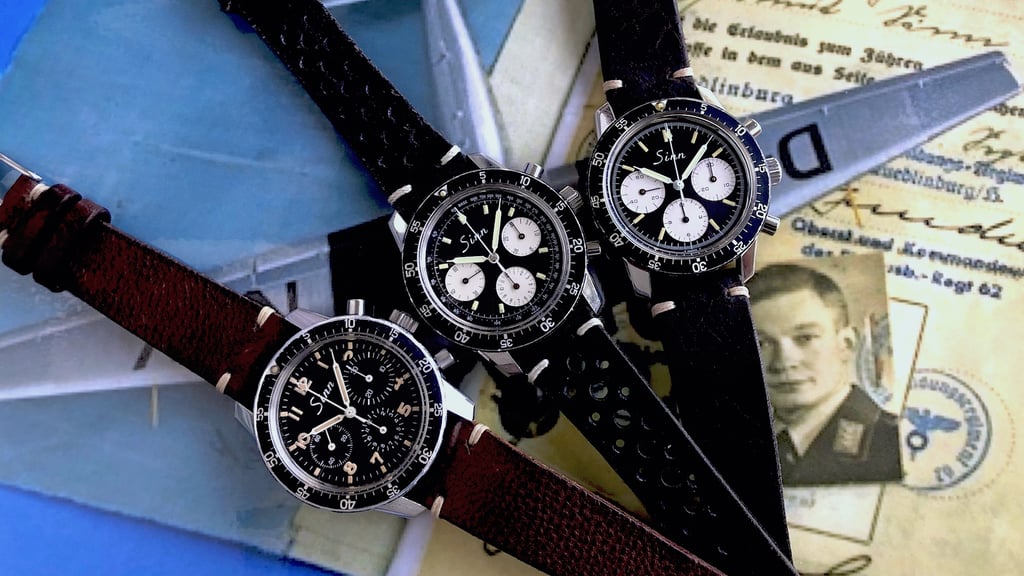

THE STORY OF A CLASSIC

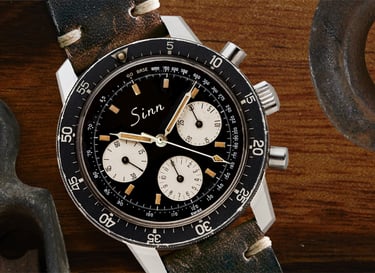
The first series of Sinn 103 with Valjoux 72 corresponded to the design and style of the LeCoultre Reference E2643, also known as "The Shark" or "Shark Deep Sea," and the Mathey-Tissot Valjoux 72.
This Sinn 103 has the serial number starting with 296XXX, and the dial is only printed with "Swiss" below the 12-hour counter.
SINN 103
SINN 103 A




LeCoultre Ref. E2643
Caliber Valjoux 72
Mathey-Tissot Valjoux 72
Caliber Valjoux 72


Sinn 103 A "Big Eyes"
Caliber Valjoux 726
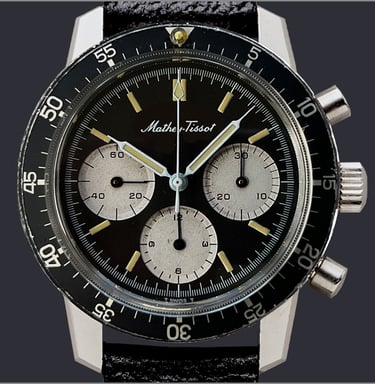

Mathey-Tissot "Big Eyes"
Caliber Valjoux 726
Later models have the "T Swiss T" imprint on the dial at 6 o'clock and were assembled from early 1970 to 1974.
The Sinn 103 with a gold-plated Valjoux 726 movement occasionally appears as well.
These transitional models with Valjoux 726 are the watches that were assembled after 1974 and until around 1978.
The successor model to the Sinn 103 with Valjoux 72 was the Sinn 103 A "Big Eyes," featuring large white subdials and the Valjoux 726 movement.
His connections to Breguet and Mathey-Tissot, whose owner Helmut Sinn knew very well from the airfield, were crucial for this model series.
Inspired by dashboard clocks in aircraft cockpits and designed for pilots, the Sinn 103 B with the Valjoux Caliber 726 was created in the 1970s.
This model adhered to the concept and design of the second-generation Breguet Type XX pilot's watch.


SINN 103 B


The Breguet CEV series and the Mathey-Tissot Type XX models are scarcely found, and if at all, they are only offered in auction houses. These models command top prices.
Even rarer are these models with the historic Sinn logo, as only very limited quantities of them were produced.
This Sinn model corresponded to the design of the Breguet and also that of the Mathey-Tissot Type XX, featuring no numerals, only baton markers in the 15-minute register, and a small
propeller hand.
SINN TYPE XX





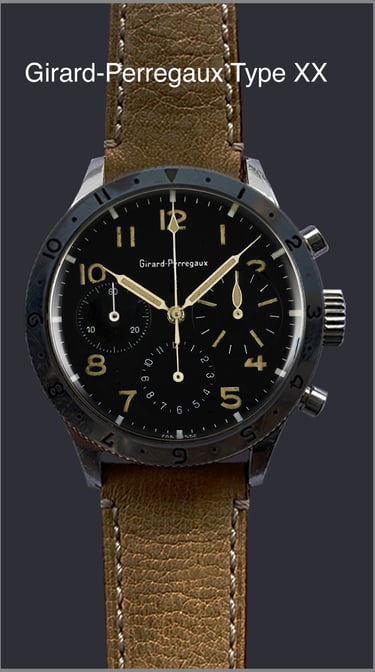


The Sinn 103 C, which was assembled in very small quantities for "Helmut Sinn Spezialuhren" in the 1970s, was based on a design of the chronograph by Mathey-Tissot with Tachometer Scala.
The case is identical among all the showcased models, and the serial numbers are also within the respective range starting with 333 XXX.

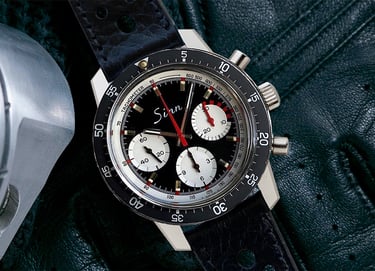
SINN 103 C

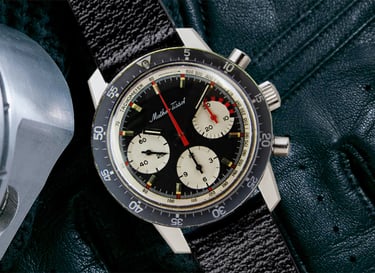
Mathey Tissot was a gray eminence in watchmaking and supplied the great ones with chronographs and repeaters.
The brand was founded in 1886 in Les Ponts-de-Martel, in the heart of the Swiss Jura Mountains. Originally established as Mathey, the name was later expanded to include "Tissot" to avoid confusion with another well-known watch brand.
It's important to note that Mathey-Tissot should not be confused with the brand "Tissot," which is a separate and independent Swiss watch brand.
MATHEY-TISSOT
SINN 4 ATM
This is one of my favorite pieces, the rare Sinn 4 ATM, this model was offered as both the Panda Dial and the Reverse Panda in very limited quantities by Helmut Sinn.
The design and the concept of this model appeared between the years 1968 and 1971 at Jaeger for the French market, with a production of approximately 100 pieces.
By the end of 1972, after the official sale of the Jaeger 4 ATM by Jaeger, Helmut Sinn acquired the parts / remaining stock and then marketed them with the Sinn logo.




JAEGER 4 ATM
The watch earned its nickname due to the engraving "4ATM" on the back of the case.
A distinctive feature of the "4ATM" is the countdown bezel, where the numbers are displayed in reverse order.
A countdown bezel is designed to count down a specific time duration in reverse.
This function is particularly useful for activities where precise timing is crucial. Overall, the countdown bezel allows for easy and quick time measurement for certain time-sensitive activities.
"The beginnings of the new Sinn 103."
The models from around 1988/1990 are the precursors to today's Sinn 103. They were introduced with the automatic caliber Valjoux 7750 and manual wind caliber Valjoux 7760.
The initial models of the Sinn 103A were presented in a Submariner 20ATM case, and the Sinn 103B featured a Sub Sea case and Movado bezel.
Only limited quantities of this model were assembled.
It wasn't until the new cases, the shape of which has remained virtually unchanged to this day, that the larger quantities started around 1990/1991. That marked the true birth of the 103 with significant numbers at Sinn Spezialuhren.



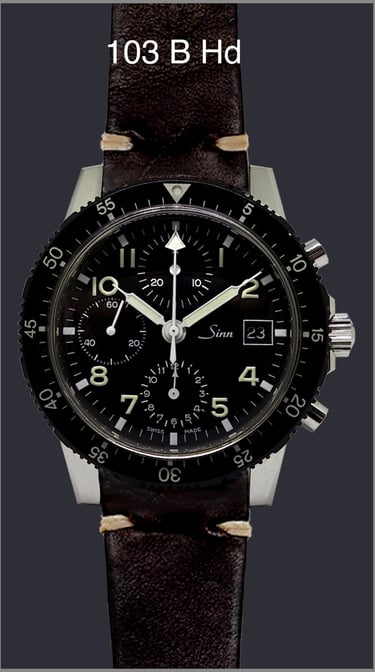
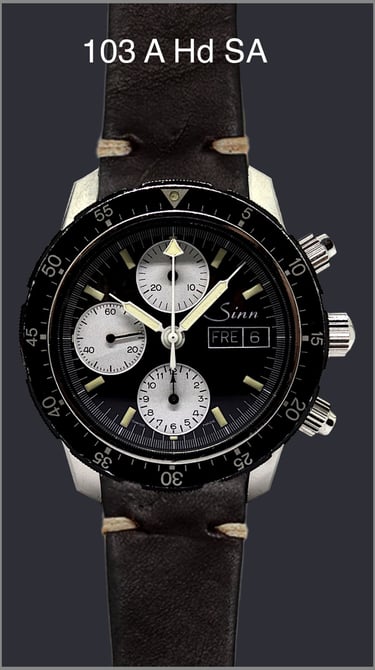




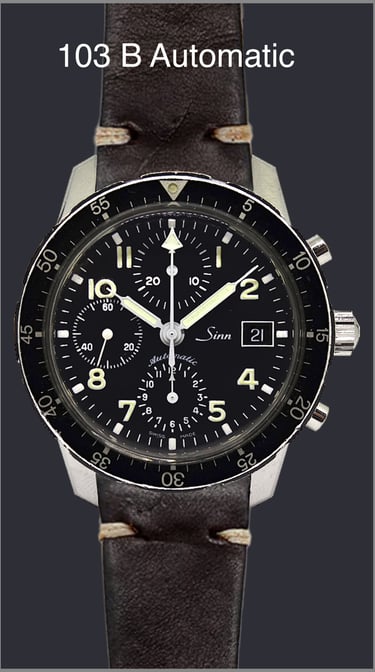
SINN 103 Mond
The Sinn 103 with moon phase was sold between 1993 and 1995, during the transitional period from Helmut Sinn to Lothar Schmidt, in a limited quantity of only 600 units.
Few had sapphire crystal and a sapphire crystal back, as the selling price was significantly higher compared to the acrylic glass version.
The Sinn moon phase was available as a manual wind with Valjoux 7768 and as an automatic with Valjoux 7758. The early ones featured the old Sinn logo with the elongated "S," the early automatic versions had the "Automatic" lettering with a "C," and later, starting from 1995, the new Sinn logo appeared with "K" for automatic.
These are some of the last models produced under the direction of Helmut Sinn.


VINTAGE SINN COLLECTOR
Copyright © Vintage Sinn Collector 2023


